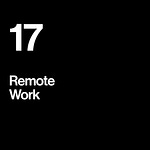Supported by:
Daylight Computer: the healthiest computer
Baked Graphics: amazing 3D video mockups
Framer: the best website builder for designers
ProtoPie: the best hi-fidelity interface prototyping tool
Research through Design is a way of producing "research" that comes with opportunities to practice the craft of design. It's a way of expressing and materializing knowledge and insights, acquired based on hands-on design work, packaged into a scientific format.
Research through Design is something you might hear about if you study design at the graduate level. It's especially popular among interaction designers and human-computer interaction people. The appeal of it, if you're involved in academic studies, is pretty clear: It allows you to bring in craft and creativity – all the fun parts of design – while you're doing the academic things.
For design professionals, the value proposition is a little more obscure. But, even though it's better known as an academic idea, Research through Design is strongly connected to product and innovation management through ideas like Design Thinking, Design Sprints, and Lean Startup.
If you're involved in innovation, product management, or UX design, you can look into Research through Design to expand your expertise. Things you'll find include very detailed case studies of design work, and sophisticated discussions on things like design process and insights analysis.

Why this episode?
As a design and computer science researcher, I've been involved in Research through Design for about a decade. It's a way of working where I could spend time around hands-on creative work, which I really enjoy.
Alongside my own research, I also supervised student projects, reviewed research papers, and had conversations with colleagues where research through design is a really central topic. While doing these things, I run into a lot of problems with all of us being aligned, in terms of our mental models, ways of working, and ways of talking about this kind of work. Doing and talking about Research through Design as a team is really hard.
This happens because Research through Design is, as of yet, a complicated topic. When we're dealing with a subject that is so complex, alignment and communication are inevitably challenging,
Research through Design is a complicated topic because it's an idea that comes from academia. It's known, performed, and discussed mainly among university scholars. If you want to learn about it, you'll have to look into research papers and academic books, or talk to professors and graduate students. In these academic communities, we are expected to "contribute" new ideas all the time, and to pay a lot of attention to detail. Thus, the many papers, lectures, books have been produced about Research through Design over the last 30 years or so have mainly served to expand the topic: proposing new ideas, setting benchmarks, building case studies...
Come today, we have achieved a critical mass of knowledge and definition in the genre of Research through Design. It's time to look back and distill some of these ideas into resources that are legible to creatives and professionals.
This episode, our first on Research through Design, is about its origin and purpose – how and why it was "invented", and how it's useful for particular kinds of questions and challenges.
Later, we will cover the processes and methods we use in Research through Design, how to evaluate and develop a taste in it, "deliverables" for documenting and presenting your work, writing and publishing academic papers, and how all of this fits into commercial work.
If you are doing or intending to do Research through Design, all of this will let you have more speed, clarity, and fun as you go through your projects. You'll also find here the words to communicate the value of both research and design to non-academics.

Why does Research through Design exist?
When we talk about "design research," we're usually talking about one of 3 different things. The first one is Research for Design: information gathering you would do before and during a design project, in order to make good design decisions. Second: Research into Design, which is, for example, when a historian or anthropologist does research about how designers work.
Before we move on to the third one (which is Research through Design, obv.) here's what you have to realize: If you're doing Research for or into design, you're probably not doing design at the same time. Design and research, in these situations, are separate activities.
Research for Design implies that you do the research first, and then you do the design (or someone else does the design, based on your results). Think: market research, need-finding, or discovery, which you would do before you have any designs to begin with.
With Research into Design, usually, someone else does the design, and you study what they are doing. You might go to a design studio and spend time with designers, and then write an article about how they work. (This is, in fact, what our Conversations are about.)
But what if you want to do design? What if you want to run a research project in which you actually create a product? This is where Research through Design comes in.
With Research through Design, you set out to ask and address questions – which may or may not be about design. Design is a tool or method you use for this purpose. This means that the research and the design are done at the same time, by the same person, or at least the same team. And this is very important: it brings us to why the idea of Research through Design came into being in the first place.

The term Research through Design (along with Research for and into Design) was coined by Professor Christopher Frayling in 1993. Frayling, a professor at the Royal College of Art, noticed, at that point in our history, that the various disciplines of art and design are becoming more and more a part of the university and of scientific research. And this actually a modern phenomenon, happening only recently.
To be clear, we're not talking about education in design and craft, where we have the Bauhaus from 1919, and the industrial design program from 1934 at Carnegie Institute (today known as Carnegie Mellon University)... Design being taken seriously as a research method is quite recent, beginning around the 1960s.
The core of the problem that Frayling wants to solve is that designers are demanding respect and recognition at universities, also known as degrees and jobs – things that engineers, biologists, mathematicians, and other people are able to have. But at this point, designers don't really have a tradition of research, which leads to those things.
But what does it even mean? What even is this thing we call "research", and how does that make a difference? How is that different from a school that teaches design, or having a history and wisdom of the craft?
The short and rather blunt answer is that "research" means "writing." A little more precisely and more bluntly, "research" means articles, written mainly in English, reviewed and accepted by committees (of mainly people with PhDs), and published in journals that are distributed mainly to universities.
You might think that's a narrow-minded view. Indeed, this is the problem that we're attacking with Research through Design. It is a platform for widening the academic community to accept designers. Academia is built on a very strong tradition of written research. Just like a designer might be judged based on their portfolio, academics might be judged based on their written publications. And having codified their way of doing things as Research through Design, designers could finally get academic positions.
Before Research through Design, if you wanted to do design research and have an academic job; you had the option to belong in the psychology or anthropology departments. You could use their research methods, publish in their journals, and still do work that serves to inform design. Some of the first research projects which deal with human-computer interaction, user experience, and the design of computer software were in fact done in this way. (We talk about one of them below).
Before Research through Design, if you wanted to belong in the design or art departments and publish research, a lot of that would be analyzing design. This would be Research into Design, rather than actually doing your own design work. You'll find a lot of this in some of the earliest research journals, like Design Studies and Design Issues.

Today, the majority of research projects that our grad students work on are done in the form of Research through Design. The actual research methodology that our students implement for their master's theses, for example, are based on things like Design Thinking, or Double Diamond, or Lean Startup. They are taking a process that is intended for creating new products or business innovations, and using that as a research method. And this is all thanks to Professor Frayling, who was a pioneer in explaining this approach to the academic establishment.
Why do Research through Design?
Now we understand why the genre of Research through Design was brought about. But the question remains: why would you actually do Research through Design? What is it good for?
The ambition of Research through Design is to fit design knowledge into the format of scientific research. We do it, as designers, to conform to academia, and we are rewarded with degrees and resources. Nevertheless, we still need an intrinsic reason to do this work. So what is it that we achieve by actually doing Research through Design?
Since this is now about research, the answer boils down to what kinds of research questions we can address with Research through Design – the things that are not possible with other research approaches.
Fundamentally, there are two kinds of questions that Research through Design is great for.

The first is about design itself.
Specifically it’s about informing how to design effectively with particular materials or technologies that we don’t really know how to handle yet. The "newness" doesn’t have to be technological – it could also be about the process or management of design, about how to engage with different stakeholders, and about situations that we don’t yet know how to deal with.
Research through Design allows us to engage with these new situations and discover all kinds of insights and new questions (also known as unknown unknowns). And many of these are only possible to discover by doing experiments – by actually building designs.

The second kind of question is about people.
How do people think and behave in particular situations, perhaps when they engage with particular designs? What is it like to be that person, in that situation?
On a different level: how can we explain what we know about organizations and societies, in order to navigate them better and create design-driven change?

Research through Design enables you to deal with all of these questions, by way of doing design.
This is unique among other research methods, because it allows us to see how things change when we intervene in a situation. It shows us what happens when we insert a new design into people's lives.
Social sciences also tell us about people, but a lot of social scientists try to observe how people and cultures exist in a "natural" state. They are concerned with how things are. Research through Design, on the other hand, is about the effect that we have on the world as designers. It's about how things could, should, or might be.
Engineering research can tell us how to design with new technologies and materials. But often, the impact of those new designs on the lives of people are not in the scope of what engineers are looking for.
Ultimately, Research through Design allows us to translate the direct experience of building designs and interacting with them into scientific knowledge.
To be clear, Research through Design is not exactly a scientific method. But it allows us to store design knowledge in the recording system1 of scientific literature. And that is amazing.
Examples
I'd like to present three examples of Research through Design projects which illustrate the ideas above.

Xerox (1980s)
In the mid-1980s, Xerox was making photocopiers that were expensive and complicated. If you had one, you probably employed a technician to take care of it. This meant that Xerox could only sell their products to companies who could afford to keep them running.
To expand their market to smaller businesses who can't afford specialists, Xerox wanted to design machines that everyone could use.
To figure out how, the team at Xerox produced innovative prototypes for user-friendly machines. They put them in actual offices where people were working. They employed anthropologists, psychologists, and other kinds of researchers to analyze the impact of doing this.
You might notice that this was done in the 1980s, before idea of Research through Design came about. Hence, a lot of this work was published in cognitive science, psychology, and anthropology. But as the subject matter was obviously relevant to technology and computers, this way of doing research developed into a movement in computer science. You could actually say that this the beginning of what we now call Human-Computer Interaction.2

This project was pioneering work in interaction design and design systems. For example: the team documented how they arrived at using the color green to indicate where to insert paper and to start the machine, and using blue to indicate where you're supposed to interact with paper. They used light-colored plastic for parts of the machine that are touched and used often, and dark plastic for parts that are perhaps reserved for experts. They developed a system for the graphics and instructions that appear on the machine. Ultimately, they captured this knowledge in handbooks for designers and engineers.

This is really amazing early work in developing things like design systems, which digital product designers are very familiar with today. It's also the beginnings of what we call user experience design, and shows us how a lot of the methods we use for ux design today are really coming from anthropology and psychology.

Slow Game (2018)
Our second example is more recent, from 2018: the Slow Game by Will Odom and colleagues from Canada.
Will is in fact one of my favorite design researchers. He and his colleagues write with a level of legibility that's hard to find in academic writing, and the level of craftsmanship in their designs is impressive.3

The Slow Game, initially designed by students and later developed in research, is a cube made out of wood. It looks pretty small, about half the size of a Rubik's cube or the size of a small apple. Easy to grab in the palm of your hand.
Embedded inside the wooden surface on one of the sides is an 8x8 array of LED lights. – a display with pixels embedded under the wood.

This gadget is actually a Snake game, like we had on the old Nokia phones. The LEDs form a snake that moves around and grows by eating other pixels, and you die if you crash into the wall.
What's interesting about this design is that the snake moves only one pixel every 24 hours. It's super slow, and controlled by physically rotating the cube.

The slowness in this project is not only regarding the interaction design, but also in terms of the fabrication processes. The design is crafted from felled wood that was found after a storm, requiring special care to stabilize. The final form as well as the engineering of the internal electronics was developed through many iterations. The whole process is documented in a collection of research papers, which industrial and interaction designers can refer to for tactics and inspiration.

Ultimately, the Slow Game tells us a lot about how to design based on a philosophy of slowness and calm, and what it's like to actually live with these designs, exploring themes like the grey area between calmness and frustration.
Drone Chi (2020)
Our final example, Drone Chi, is from my own research. The prototype and experience design was is the brainchild of my dear friend Joseph La Delfa, who is still building on the project as part of his ongoing PhD.
Drone Chi is based on a person moving together with a drone, performing a meditative movement exercise inspired by Tai Chi.
The drone that we used is very small (around 10cm wide), and designed to look like a lotus flower using custom 3D printed parts. The system uses motion capture to both detect the movements of your hands and your body, and to fly the drone in a slow and precise way in response to the body.

Drone Chi pushes its technological material – the drone – into an unusual design space. The drone is usually associated with a jarring, uncomfortable experience because of its annoying sound and surveillance capabilities. This project explores how to craft calm, positive, therapeutic experiences using this unfavorable material.
In addition to the design insights and creative outcomes, the result of this work has been to elevate the emerging technology of interactive drones into an accessible design material. Building on Drone Chi, we published open source code and guides for developing applications with interactive drones, and told the tale of how we integrated engineering design and philosophical inspirations on the level of design process management.
We discovered things like how to design with the sound of a drone – one of the most annoying sounds in the world – and fly in a way where people enjoy the sound as a part of a meditative experience.
Today, we are still investigating how we might use this design in healthcare, including physical therapy and diagnosing movement-related issues, as well as exploring new interaction techniques building on movement data and AI.
Wrap-up
This is a preview of what you might expect from this genre of scientific literature called Research through Design. To recap the points:
The idea of Research through Design was proposed in the 1990s to give a platform for designers to enter the academic community and for design knowledge to enter the recording system of scientific literature.
Research through Design is useful to figure out how we can deal with materials, technologies, and situations that are new, and also to learn about people and the world. This makes it useful in practice, because it tells us about our customers, and materials, and management. It helps us figure out how to design, and to understand the impact of our designs.
We looked at three examples from industrial and academic work, to see how all of this is actually done.
This episode is meant to be a mere introduction. In future episodes, we'll dive into the methods we use in Research through Design, how you can develop a taste and skills in it, various kinds of deliverables that we use in this work, and other ideas that you will be able to deploy in your own research.

Links and Resources
Bowers (2012). The Logic of Annotated Portfolios: Communicating the Value of ‘Research through Design’. In Proc. DIS. [ACM Digital Library]
Change by Design* by Tim Brown
Conversation with Virgil Abloh on Vestoj
Design Studies: The Interdisciplinary Journal of Design Research
Desmet, Overbeeke, & Tax (2001). Designing Products with Added Emotional Value: Development and Appllcation of an Approach for Research through Design. The Design Journal, 4(1). [Taylor & Francis Online]
DiSalvo, Forlizzi, & Gemperle (2004). Discovering and Extracting Knowledge in the Design Project. In Proc. DRS. [PDF from designresearchsociety.org]
Hauser, Oogjes, Wakkary, & Verbeek (2018). An Annotated Portfolio on Doing Postphenomenology through Research Products. In Proc. DIS. [ACM Digital Library]
La Delfa et al. (2020). Designing Drone Chi: Unpacking the Thinking and Making of Somaesthetic Human-Drone Interaction. In Proc. DIS. [ACM Digital Library]
La Delfa et al. (2020). Drone Chi: Somaesthetic Human-Drone Interaction. In Proc. CHI. [ACM Digital Library]
Lesko (1997). Industrial Design at Carnegie Institute of Technology, 1934–1967. In Journal of Design History. [Journal's Website]
Odom et al. (2016). From Research Prototype to Research Product. In Proc. CHI. [ACM Digital Library]
Odom et al. (2018). Attending to slowness and temporality with olly and slow game. In Proc. CHI. [ACM Digital Library]
Odom et al. (2019). Unpacking the Thinking and Making Behind a Slow Technology Research Product with Slow Game. In Proc. C&C. [ACM Digital Library]
Sprint by Jake Knapp
The Double Diamond by the Design Council
The Lean Startup by Eric Ries
The Three Faces of Design Research on Design Disciplin
The Profession of Human-Computer Interaction on Design Disciplin
The Story of Design Thinking on Design Disciplin
Reading List: Research through Design Classics
Design Research through Practice* by Ilpo Koskinen, John Zimmerman, Thomas Binder, Johan Redström, and Stephan Wensween (2011)
Research through Design in the Encyclopedia of Human-Computer Interaction
Frayling (1993). Research in Art and Design. Royal College of Art Research Papers 1(1). [PDF from rca.ac.uk]
Desmet, Overbeeke, & Tax (2001). Designing products with added emotional value: Development and application of an approach for research through design. The Design Journal. [PDF from tandfonline.com]
Zimmerman, Forlizzi, & Evenson (2007). Research through Design as a Method for Interaction Design Research in HCI. In Proc. CHI. [ACM Digital Library]
Zimmerman, Stolterman, & Forlizzi (2010). An analysis and critique of Research through Design: towards a formalization of a research approach. In Proc. DIS. [ACM Digital Library]
Bowers (2012). The logic of annotated portfolios: communicating the value of 'research through design'. In Proc. DIS. [ACM Digital Library]
Gaver (2012). What should we expect from research through design? In Proc. CHI. [ACM Digital Library]
Credit goes to the late Virgil Abloh for conceptualizing fashion as a recording system – I took the liberty of extending his idea to the world of science and research.
Technically this is what we call the “second wave” of HCI, but that’s a whole other episode…
Will and co. are so committed to the craft of product design, they have been cultivating a new way of design research around something they call research products, rather than prototypes.

















What is Research through Design?